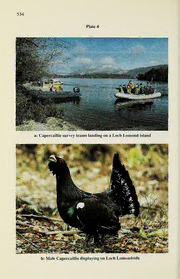
Capercaillie on Loch Lomondside PDF
Preview Capercaillie on Loch Lomondside
534 Plate4 a: CapercailliesurveyteamslandingonaLoch Lomond island b: MaleCapercailliedisplayingon Loch Lomondside 535 I would like to thank Mr, Geoff. Hancock, Glasgow Museum for arranging the loan ofmaterial and for providing the necessary data and Dr. Mark Shaw for consulting the SIRI on my behalf. Reference GEORGE, R.S., 1994. Provisional Atlas ofthe Insects ofthe British Isles, Part 4, Siphonaptera. B.R.C. Huntingdon. NORMAN Capercaillie on Loch Lomondside TAIT Over the centuries, the turkey-sized Capercaillie Tetrao urogallus (Plate 4b p.534) has had variable fortunes. A member of the grouse familiy, the bird is mainly resident in pine woods hence the oldername ofWood Grouse. The “English” name Capercaillie is derived from the Gaelic language and translates as “Cock ofthe Woods”. Possible over- hunting, habitat destruction and the bird’s life-long fidelity to a restricted home range, resulted in the Capercaillie becoming very rare between 1745-60 and eventually becoming extinct in Britain. Colonel George Montague, one of the most eminent omothologists of his day, was present when the lastknown Loch Lomond Capercaillie was killed “near the upper end of the loch” in the early 1780’s (Stephens, 1819). Early literature records that a few birds lingered on until around 1771 in the Abemethy and Glenmoriston forests and the last known indige- nous Scottish Capercaillies were shot on Deeside in 1785 (Sharrock, 1976). In 1837 Lord Breadalbane introduced 48 Capercaillies which he imported from Sweden over a period of three years. The birds were released at Taymouth Castle in Aberfeldy. Since then the Capercaillie has colonised much of it’s former ground assisted by later successful re-introductions in the north-east with a record of a pair breeding in 1877 as far south as Dougalston, Milngavie - 48 miles from the main centre ofintroduction atTaymouth! (Harvie-Brown, 1879). During this re-colonisation, females often preceded males into new areas where they occasionally paired with blackcock. One such blackcock-caper male hybrid, shotnearCampbeltown, was exhibited to the Natural His- tory Societyof Glasgow in 1872 by Mr. James Lumsden. (Lumsden, 1876). After the re-introductions in the north-east of Scotland, the Capercaillie was first reported on Loch Lomondside in 1867 when a 536 female was shot at Ross Priory by Sir George Leith-Buchanan who "did not meet with a bird there until 1877 where he again shot a female” (Harvie-Brown, 1879). Some Capercaillie were introduced on the Duke of Montrose estates around the south-east shore of Loch Lomond in the early 1870’s with a pair recorded breeding there for the first time in 1878 (Perrie,1951). About this time, the introduction of Capercaillies on a small scale was now a popular experiment on many estates throughout the country. No doubt the birds were introduced for sport but a report on their edibility written in 1871 states "from the rankness of their flesh they are not much esteemed for the table - a quality which in these degenerate poaching days must lessen the chances of their destruction" (Gray, 1871). Numbers continued to increase on Lomondside and a report of 1895 states that the bird "has within the past ten years become plentiful in all suitable woods around the loch" (Lumsden & Brown, 1895). The "chieftain of the grouse tribe" reached a national population peak around 1914 but numbers declined during and between the two world wars. In the Loch Lomond area Capercaillie remained "plenti- ful" up to 1939 but decreased after that date due to tree-felling and to excessive shooting in some places, though a few breeding birds remained on the Loch Lomond islands and at Gartlea (Perrie, 1951). Between 40-50 breeding birds were reported around Luss in the late 1940's but on the islands numbers were still declining. This was believed to be due to increasing disturbance by campers and also due to the killing ofmany female birds at the annual Fallow Deer shoots held for the villagers by the late Sir Iain Colquhoun (Perrie, 1951). The present status of this impressive bird on Loch Lomondside is currently being studied. (Plate 4a p.534). That they have survived at all is both fortunate and encouraging. Recentextensive surveys carried out collectively by the Scottish Ornithologist's Club, Scottish Natural Her- itage, Glasgow University and the Loch Lomond Park Authority show a basically stable population. In 1992 the survey revealed 42 adult birds. The count in 1993 recorded a total of 48 adult birds on four islands - 33 males and 15 females (Zonfrillo, 1993). These numbers suggest a stable population but the count on the 1994 survey dropped to a lower figure. Isolated pairs have also been recorded breeding in suitable woodlands surrounding the lochside. The above results are cal- culated to represent around 2.5% of the national population based on the best current estimate ofaround two thousand birds. 537 The present surveys, supported by some GNHS members, confirm the national importance ofLoch Lomondside for Capercaillie. Further research and continued surveying is required to establish what factors affect this unique population ofthese handsome and exciting birds. References GRAY,R., 1871.TheBirdsoftheWestofScotlandincludingtheOuterHebrides.Glas- gow. HARVIE-BROWN,J.A., 1879. TheCapercaillie inScotland. Edinburgh. LUMSDEN,J., 1876. InProc.Nat.Hist.Soc. Glasg. 2: 195. LUMSDEN,J. &BROWN,A., 1895.A GuidetotheNaturalHistoryofLochLomond. PENNIE,I.D., 1951. DistributionofCapercaillieinScotland.Scott.Nat. 63: 4-17. SHARROCK, J.T.R., 1976. TheAtlas ofBreedingBirds in Britain & Ireland. British TrustforOrnithology. STEPHENS,J.F., 1819. Shaw'sGeneralZoology2: 268. ZONFRILLO, B., 1993.CapercapersontheBonnieBanks.ScottishBirdNews31: 10. Book Reviews BirdsinWales R. LOVENGROVE, G. WILLIAMS &1. WILLIAMS T. &'A.D. Poyser,London, 1994, 371 pp.,black&whitedrawings, maps. Hardback,ISBN0 85661 0690,£28.00. Essentially a companion volume to those of Scotland & Ireland. All species reliably recorded in Wales are dealt with in a briefbut thorough manner. There are maps for some,butnotall,breedingspecies. Importantspeciesarecoveredingreaterdepththan scarcevagrants, whicharenotedlargelybytheirdateofoccurrence. Like Scotland, Wales still has some relatively untouched upland areas and islands and some bird species thriving there are found in very few otherplaces. This interest- ing book is essential forvisitors to Wales and I can thoroughly recommend it, even if the reader never gets there. The authors are to be congratulated on a good job well done. BERNARDZONFRILLO
